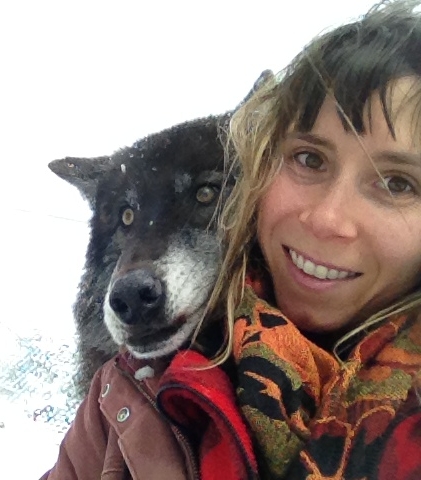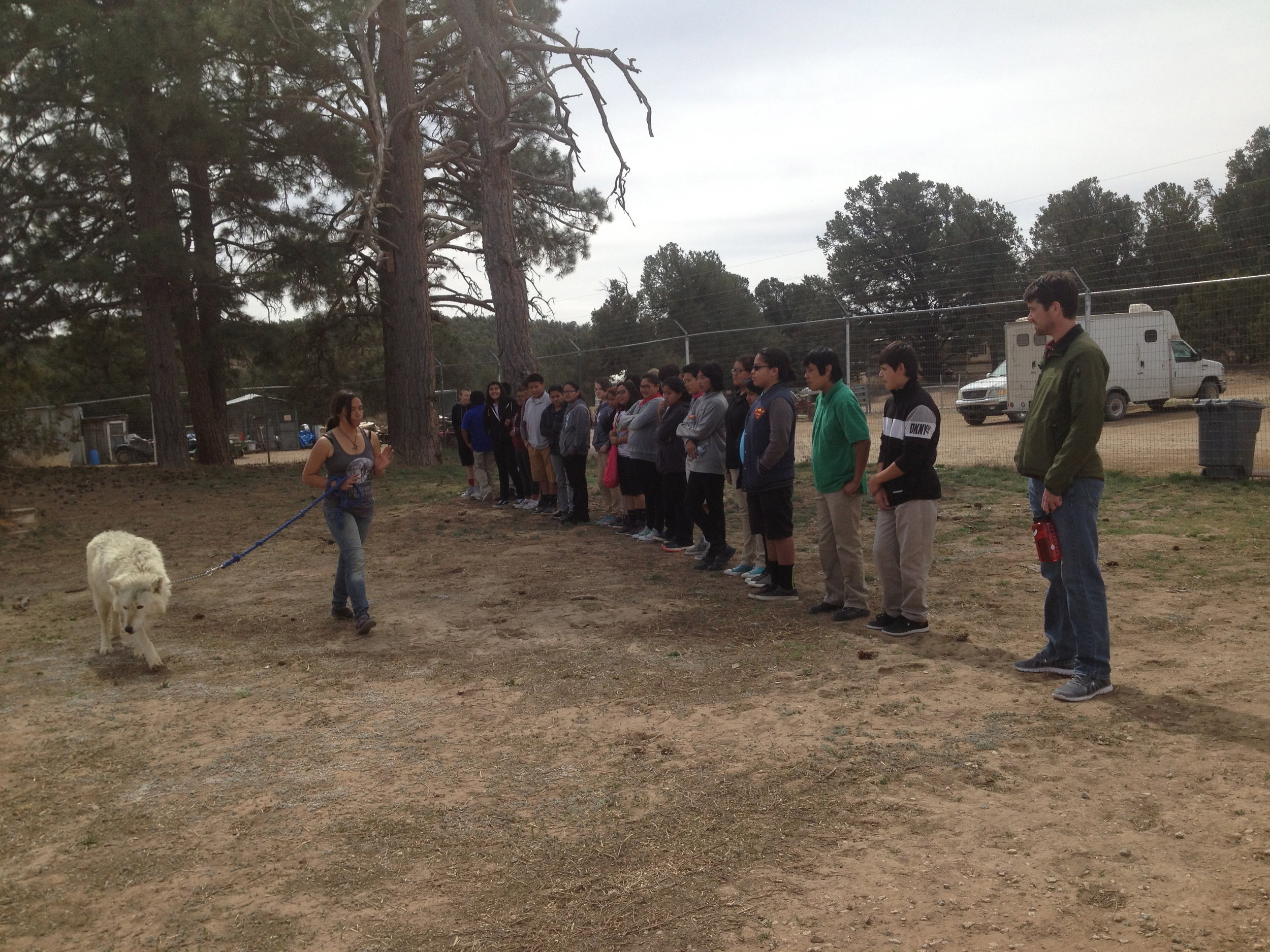Shaggy Pack of the greater "Westeros Pack" at Wild Spirit Wolf Sanctuary.
From Left: Shaggydog, Jon Snow, Shae and Summer.
We spent two beautiful years living and working at Wild Spirit Wolf Sanctuary (WSWS), a wildlife sanctuary in rural New Mexico that rescues wolves, wolf-dogs, coyotes, Australian Dingoes, New Guinea Singing Dogs and foxes from the exotic pet trade. With a mission of rescue, lifetime sanctuary, and education, WSWS is open to the public, accepts short and long-term volunteers, and is run by a small group of dedicated staff and volunteers mostly living on site and off-grid in the high desert mountains at 7,500 feet above sea level. The sanctuary is open to visitors all year round and sees thousands of international guests annually.
This post describes a day in the life at Wild Spirit for a staff member (though most of the activities are done by long-term volunteers as well).
Dawn
Dawn from our cabin.
Waking to the howls of the wolf pack and wild coyotes singing to the sunrise is a refreshing way to begin each day.
Morning Rounds (Part I)
Chadley making "med-balls" as part of Morning Rounds.
Each day, a different staff member or volunteer is assigned to Morning Rounds and Guard Duty, tasks that open and close the sanctuary for the day, while ensuring the safety and well-being of each rescue. The assigned person heads to Wolf Kitchen an hour before the work day begins to make supplement and medication meatballs, check on the rescues, and distribute meds as needed.
Animal Care
Above: Program Director Nikki with Lucian. Below (L to R): Our friend Silvana, visiting from LA, filling up Dakota's water bucket. Chadley taking care of Nakota and Silva.
Almost everyone starts their day at the sanctuary performing "Animal Care" (which is arguably the best part of the day). Each morning, staff and volunteers care for the animals in their assigned habitats, which are chosen based on each personnel's level of experience, their personality, and the personality of each rescue. Depending on the number of staff and volunteers, this can be 2 – 8 habitats per person. Animal Care consists of socializing with animals, cleaning water buckets, filling waters, and clearing habitats of waste and debris. It is important to note that only some of the rescues enjoy human interaction, and certainly not all. Socialization is never forced on any rescue, and is dictated by each rescue with each caretaker. Some animals are off-limits to the touch out of safety measures and respect for the given rescue.
Clockwise from Top Left: Nikki with Contessa, Chadley with Romeo, Chadley walking Lucian (on Lucian's birthday), Nikki with Riot & Cinder.
Enrichment
Above: Nimoy with his "present toss." Below (L to R): Contessa out on a walk visiting her friends Rae, Nikki, Stefanie, Kailyn and Matt. Riot and Cinder scent rolling on bug spray.
For some animals, social time with humans can be enrichment enough, but other special enrichments to keep rescues fit and stimulated include treats, meaty bones, going for walks, interesting scents to smell and roll in, and toys like boomer balls or even stuffed animals (only approved for some).
Feeding
Above: Forest Pack and Powder Pack sharing elk. Below (L to R): Nikki feeding Maki. Feeding Tour guests with Teton & Shasta.
To replicate a natural diet, Wild Spirit’s rescues eat 5 days a week, fasting on Mondays and Thursdays. This is because wild canines do not eat every day in the wild, but only when they catch food. On feeding days, most rescues receive frozen food such us meat loaf bricks of 2 - 5 lbs each, frozen chicken (pieces or whole) and other delicacies like elk heads and organs. Sometimes entire carcasses are given to larger packs. Those with very special diets receive an individually prepared meal just for them (typically limited to the very elderly and/or rescues with serious health conditions). The Sanctuary's smaller canine rescues; like foxes, Singing Dogs, Coyotes and Dingoes each have specific diets tailored to their particular nutritional needs.
Clean Up
Our cousin Eric, visiting from NJ, washing food buckets after a Feeding Tour. Thanks, Eric!
After "Animal Care" time, each person cleans the kitchenware and buckets he or she used for food and waste throughout the morning.
Morning Rounds (Part 2)
Wild Spirit's courtyard, where guests gather before a tour.
The person who did the first part of Morning Rounds checks the sanctuary after feeding, makes sure all rescues are alive and well, have plenty of water, that habitats are locked and secured, and the tour path is presentable for guests.
After animal care, the rest of the day is filled with various projects done individually or in teams. With a small group of staff and volunteers, most have a hand in almost every aspect of sanctuary operations.
L to R: Tina and Courtney walking Australian Dingoes Glacier and Kooyong.
Head to the Office
Event Coordinator Chadley swamped with phone calls in the office.
For the office contingent, there’s always plenty to do. Answering inquiries, fundraising, scheduling animal rescues, guest activities and overnight stays, vet visits, outreach events and tours, project planning, volunteer management, and more.
Log Animal Observations
Assistant Director Crystal Castellanos taking care of Shaggydog in the Animal Care Office after one of his back legs was amputated.
Staff and volunteers are vigilant about reporting animal observations such as strange behaviors, sudden changes in mood or disposition and eating and digestive habits, pack dynamics, injuries, and anything else out of the ordinary. After animal care, observations are documented in a detailed log.
Go to the Vet or an Outreach Event
Above: Nimoy waiting to be seen at the eye doctor. Below (Clockwise from top Left): Flurry ready for his eye surgery.Thunder trying to escape his vet appointment. Board Member Jan with Storm at the New Mexico State Fair. Executive Director Leyton Cougar delivering a presentation with Flurry at the Jean Cocteau Theatre in Santa Fe.
While these activities don’t happen everyday, staff and volunteers do take rescues off property from time to time. Rescues go to the veterinarian for anything from routine check ups to treating illnesses and sudden emergencies. Going to the vet can happen anytime, but most visits are pre-scheduled. With about 70 rescues, WSWS averages $10,000 a year in vet bills, and sometimes more.
Wild Spirit takes it’s "Ambassador Wolves" on a few outreach events per year to share the sanctuary’s mission, teach people that wolves are not pets, but also not the big bad wolf we hear about in Little Red Riding Hood, and to explain the wolf’s role in nature, and why it is critical they remain protected. Venues include libraries, theatres, schools and wildlife centers.
Rescue an Animal
Above: Rescued wolf-dog pup Quinn relaxing. Below (L to R): Rescued wolf-dog pups Leia & Quinn playing. A coyote pup being transported to another sanctuary by Executive Director Leyton Cougar.
Wild Spirit’s Director, Leyton Cougar, has traveled all over the U.S. to rescue wolves, wolf-dogs, and other wild canines in need. The sanctuary is near capacity most of the time, but openings occur, enabling the sanctuary to save a life. Even when Wild Spirit doesn’t have space, staff will do what they can to find placement for an animal, and occasionally even provide transport.
Meat Separation
L to R: Robert, Megan, Mike and Paul unloading wolf food after a"meat run." Clarissa working on meat separation.
Wolves are carnivores and need a steady diet of meat to stay healthy. WSWS has several community partners who donate meat to the sanctuary such as butchers, community pantries, and individuals. Staff and volunteers separate good meat from bad and prepare food for each animal several times a week.
Give a Tour
Romeo visiting the crowd during Courtney's tour.
The sanctuary offers several guided tours per day to the public. Staff and volunteers escort groups as small as 1 person to classes of 50 school children through the tour path describing the sanctuary’s mission, relaying each rescue’s individual story, and providing facts about wolves and other wild canines. Careful attention is given to describe the differences between wolves, wolf-dogs, and dogs, and why wolves and wolf-dogs are not pets.
Work in the Gift Shop
L to R: Kendra, Patricia, Jenna, Megan and Meg modeling new Wild Spirit sweatshirts outside of the gift shop.
The Gift Shop Gals greet guests, answer phones, stoke the fire, tidy up, and sell wolf merch.
Do Some Maintenance
Above: Casey teaching Courtney how to use the trencher. Below (L to R): Girl Scout volunteers clearing brush. Nikki on the John Deere.
The sanctuary is growing all the time, which keeps everyone quite busy. Maintenance projects can be anything from building a new habitat to weeding, updating volunteer housing, working on the rental cabins, and other habitat improvements.
Be Thankful
Above: Chadley, Eric, Sumitra, Amy, Eva, Paul and Mo happily pose to thank a donor for her generous gift of a shiny new Wolf Kitchen refrigerator. Below (L to R): Jaeger resting on Nikki's shoulder after scent-rolling on her head. Chadley and Contessa saying a happy hello.
Sanctuary life can be hectic with a never-ending workload and new challenges arising all the time. Taking time for gratitude is essential. Whether that’s a quiet moment to walk the tour path, visit a friend (human or animal), have a hug, tell someone you love them, thank a donor or a guest, or just enjoy the fresh mountain air and the sounds of raw beautiful nature, those small moments of giving thanks for the opportunity to support the wolves helps staff and volunteers recharge.
Private Tours
Above: Friend of the sanctuary, Shirl, with Storm. Below (L to R): Guests from South Africa with Dakota. A guest with Nimoy.
The sanctuary provides some Private Tours that enable guests to visit specific habitats with staff members for fantastic photo opportunities, and simply the chance to be in the powerful presence of a wolf.
Attend the Daily Animal Care Meeting
The Animal Care chore board is set with the week's tasks.
When the day is through, animal care staff and volunteers gather back in Wolf Kitchen to discuss any concerns that arose during the day, and to review the following day’s schedule.
Guard Duty
Clarissa distributing "med-balls."
An hour before sunset, the person who did Morning Rounds returns to Wolf Kitchen to make the evening’s “med-balls,” distribute medications and supplements as needed, check on all residents before nightfall, and ensure all gates are locked and secured.
Dusk
An evening hike in the neighborhood with our dog Ziggy.
It's easy to enjoy the magical New Mexican sunsets, ravens flying to their roosts, and the sounds of wolves and coyotes singing the closing of another day as you eat a nutritious meal, connect with friends, and head to bed early to wake up refreshed and ready for another day with wolves!
Arctic Wolf, Powder, on the prowl.
Clockwise from top left: Chadley with Quinn, Nikki with Cheyenne, Nikki with Sugar howling, Chadley with Jaeger, Chadley walking Lucian, Nikki with Nimoy, Nikki walking Dakota (photo by Paul Koch), Chadley photographing Jaeger, Clarissa and Courtney making med-balls, Mo doing at "ATV feed," Crystal and Forest greeting a student group tour, Eva feeding Brutus, Raven in flight, and Chadley with a baby lamb.






































